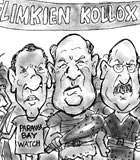Explaining the US electoral system and the role of ‘swing states’ in America
James Debono
Polls showing Barack Obama leading by margins of 7% could well be deceptive for a presidential candidate who may well win a majority of votes, but still lose the contest.
A similar freak result in Malta would bring the country to the brink of civil war, as happened in 1981, when the Nationalist Party won a majority of votes and a minority of parliamentary seats.
But in the USA, the wisdom of the founding fathers is rarely questioned and the Constitution is held sacred by most Americans. Back in 2000, despite getting 543,816 votes fewer than Democratic hopeful Al Gore, George W. Bush clinched victory thanks to Florida’s odd 25 electoral college votes, after winning just 537 popular votes more than Gore in the Sunshine State.
It was these 537 votes which determined the course of world history with George Bush embarking on the invasion of Iraq on the false pretext of eliminating weapons of mass destruction.
Surely many Americans questioned the legitimacy of Bush’s victory in Florida where thousands of black voters were allegedly disenfranchised in a state run by George Bush’s brother Jeb.
But nobody ever doubted the legitimacy of the Bush Presidency even if he was elected by a minority of Americans. Given the next chance in 2004, the Americans re-elected Bush by a landslide. Ironically, although Bush won the popular vote, some Democrats still questioned the legality of his victory in Ohio – a key swing state –which won him the election.
How the system works
Actually when the Americans vote for a President and a Vice President, they actually vote for presidential electors, known collectively as the electoral college. It is these electors, chosen by the people, who elect the President.
The Constitution assigns each US state a number of electors equal to the combined total of its Senate and House of Representatives delegations.
At present, the number of electors per state ranges from Hawai’s 3 to California’s 55, for a national total of 538 votes.
In most states, voters cast a single vote for the slate of electors pledged to the party presidential and vice presidential candidates of their choice. The slate winning the most popular votes is assigned all the electoral votes according to the winner-take-all, or general ticket, system.
In this way Bush was able to scoop all of Florida’s votes despite winning just with a margin of less than 0.5%.
Only Maine and Nebraska use the district system, which enables both contenders to win votes from these states.
Technically the President of the USA will not be elected next Tuesday. He will be elected on December 15 when electors in each State meet to select the President and Vice President of the United States. They are pledged and expected, but not required, to vote for the candidates they represent.
A majority of 270 electoral votes of 538 is required to win the US election.
Since most states have solid Republican or Democratic majorities, the election will be determined by a few thousand votes in a dozen swing states.
For while nobody expects Mc Cain to win liberal states like California and New York, nobody expects Obama to win conservative states like Texas. It is battleground states like Florida and Ohio which determine the US elections.
The Swing States
The good news for Obama in this election is that polls are not only showing him winning in traditional swing states but also gathering support in formerly safe Republican states.
The latest polls shows Obama holding solid leads in Ohio, Nevada, Colorado and Virginia, all red states won by Bush that collectively offer 47 electoral votes. Sweeping those four — or putting together the right combination of two or three — would almost certainly make Obama president.
Obama needs 270 electoral votes to win the White House. Obama can earn 252 by merely reclaiming states won by John Kerry in 2004.
There are only two Kerry states still in contention — Pennsylvania with 21 votes and New Hampshire with four — and polls show Obama leading both by a strong margin.
McCain’s best hope hinges on a surprise victory in Pennsylvania where the issue of race among the ‘white working class’ may hurt Obama, even if polls still show Obama leading.
If Obama wins Virginia, Colorado, Nevada and Ohio – all of which had voted Bush in 2004 – it will mean that McCain must win Pennsylvania without losing Florida.
An early indication on who has won the election will come from Ohio – a swing state which has 20 electoral votes which had voted for Gore in 2000 but which gave Bush his second term in 2004.
If McCain loses Ohio, Obama will most probably become the first black President of the USA.
 PRINT THIS ARTICLE
PRINT THIS ARTICLE








